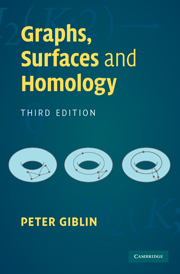Book contents
- Frontmatter
- Contents
- Preface to the third edition
- Preface to the first edition
- List of notation
- Introduction
- 1 Graphs
- 2 Closed surfaces
- 3 Simplicial complexes
- 4 Homology groups
- 5 The question of invariance
- 6 Some general theorems
- 7 Two more general theorems
- 8 Homology modulo 2
- 9 Graphs in surfaces
- Appendix: abelian groups
- References
- Index
Preface to the first edition
Published online by Cambridge University Press: 05 June 2012
- Frontmatter
- Contents
- Preface to the third edition
- Preface to the first edition
- List of notation
- Introduction
- 1 Graphs
- 2 Closed surfaces
- 3 Simplicial complexes
- 4 Homology groups
- 5 The question of invariance
- 6 Some general theorems
- 7 Two more general theorems
- 8 Homology modulo 2
- 9 Graphs in surfaces
- Appendix: abelian groups
- References
- Index
Summary
Topology is pre-eminently the branch of mathematics in which other mathematical disciplines find fruitful application. In this book the algebraic theory of abelian groups is applied to the geometrical and topological study of objects in euclidean space, by means of homology theory. Several books on algebraic topology contain alternative accounts of homology theory; mine differs from these in several respects.
Firstly the book is intended as an undergraduate text and the only mathematical knowledge which is explicitly assumed is elementary linear algebra. In particular I do not assume, in the main logical stream of the book, any knowledge of point-set (or ‘general’) topology. (There are a number of tributaries, not part of the main stream but I hope no less logical, about which more in a moment.) A reader who is familiar with the concept of a continuous map will undoubtedly be in a better position to appreciate the significance of homology theory than one who is not but nevertheless the latter will not be at a disadvantage when it comes to understanding the proofs.
The avoidance of point-set topology naturally imposes certain limitations (in my view quite appropriate to a first course in homology theory) on the material which I can present. I cannot, for example, establish the topological invariance of homology groups. A weaker result, sufficient nevertheless for our purposes, is proved in Chapter 5, where the reader will also find some discussion of the need for a more powerful invariance theorem and a summary of the proof of such a theorem.
- Type
- Chapter
- Information
- Graphs, Surfaces and Homology , pp. xiii - xviPublisher: Cambridge University PressPrint publication year: 2010



